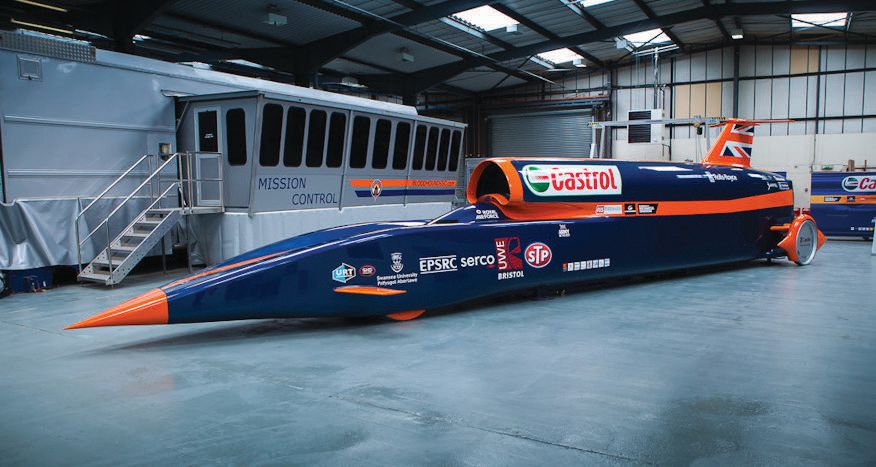Speed Demon
Dr. Edward P. Becker | TLT Automotive Tribology February 2016
Scientists use tribology and a supersonic car in an attempt to reach 1,000 mph on land.

Essentially a jet fighter without wings, the Bloodhound SSC is poised to travel 1,500 feet per second on land.
When a distinguished but elderly scientist states that something is possible, he is almost certainly right. When he states that something is impossible, he is very probably wrong.
—Arthur C. Clarke’s first law of prediction
IN 2015 THE STANDING LAND SPEED RECORD TURNED 18 YEARS OLD, which is also the longest standing land speed record in history. The Thrust SSC recorded an average speed of 1,228 km/h (763 mph) over two runs in opposite directions within one hour, becoming the first land vehicle to break the sound barrier. Why has that record stood for so long? Perhaps going faster (on the ground) is impossible.
Don’t tell that to Richard Noble and Andy Green, who between them hold the last three land speed records and are currently managing project Bloodhound SSC, with the not-so-modest goal of achieving a land speed in excess of 1,609 km/h (1,000 mph), breaking the old record by at least 33%. For comparison, that would be the equivalent of a baseball player hitting at least 93 home runs in a single season to break Barry Bond’s record total of 73!
The engineering challenges are manfold. Accelerating the vehicle requires thrust from both a rocket engine and a jet engine. However, two of the most interesting problems are tribological. Specifically steering and braking are both friction-related concerns.
The Bloodhound SSC will have front-wheel steering, so downward force on the nose wheel must be maintained throughout the run. Currently the team plans to use winglets on the front of the vehicle. Also, the wheels themselves are quite special. The wheels are expected to rotate at more than 10,000 rpm and experience maximum radial forces of over 50,000 lbs. Rubber tires would disintegrate under those conditions, so these wheels are solid aluminum.
Regarding steering, the human element presents quite a challenge. At 1,609 km/h (1,000 mph), the car will be travelling almost 1,500 feet per second. Average human reaction time is around 0.25 seconds, so to react to the track conditions, you or I would need to see—and process—visual information from at least 367 feet in front of the car. Andy Green, a British Royal Air Force fighter pilot, has faster reaction times than most, but even with world-record reflexes of 0.1 seconds he will still need to know what is coming from almost 150 feet away.
Getting the vehicle up to 1,609 km/h (1,000 mph) is one thing; stopping the 17,000-lb. vehicle is quite another. Remember that kinetic energy varies as speed squared, so increasing the top speed by 33% means dissipating about 77% more energy. Mechanical brakes (which convert kinetic energy to heat) would melt without a prohibitively large heat sink, so the Bloodhound SSC will use air brakes until the speed is reduced to around 322 km/h (200 mph), at which point the mechanical brakes can be used to bring the vehicle to a safe stop.
Just what does SSC stand for? Super Sonic Car, of course.
 Ed Becker is an STLE Fellow and past president. He is president of Friction & Wear Solutions, LLC, in Brighton, Mich., and can be reached through his website at www.frictionandwearsolutions.com
Ed Becker is an STLE Fellow and past president. He is president of Friction & Wear Solutions, LLC, in Brighton, Mich., and can be reached through his website at www.frictionandwearsolutions.com.